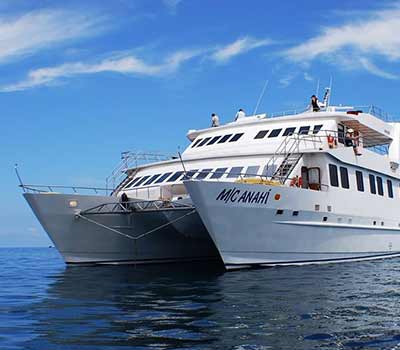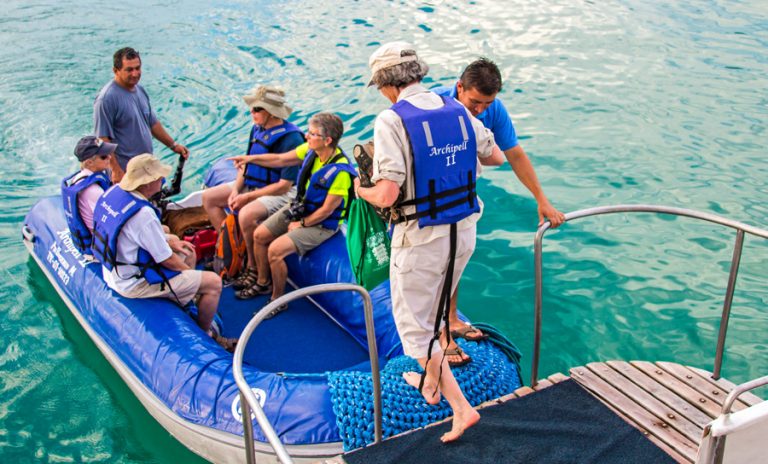Galapagos Catamaran
[tabby title=”Itinerary”]
ROUTE A ( 8 DAYS)
Included
- Accommodation in double/twin cabins or Suites with king sized beds with private facilities
- All meals during cruise, drinking water, coffee & tea
- All excursions accompanied by bilingual licensed guide as per Galapagos park approved itinerary
- Cruise Fuel Surcharge
- Transfers within the islands on cruise dates as per itinerary
- Personalized 24/7 assistance during tour.
- Snorkeling equipment for marine excursions
Not Included
- Galapagos National Park Entrance Fee US$100 per person (in cash only to be pain upon entry to the Islands)
- Galapagos Migration Card US$20 in cash per person (at Quito or Guayaquil Airport)
- Alcoholic / soft drinks, personal expenses, extras, tips and other services not specified in the program
- Travel, medical & cancelation Insurance and any services on Mainland
- All sizes wet-suits for rent on board (in cash)
- Flights to Galapagos from Quito / Guayaquil
- International flights to/from Ecuador.
Highlights
- Explore the worlds second largest volcanic crater at the summit of Sierra Negra volcano on Isabela Island
- Swim alongside marine iguanas, flightless cormorants and tropical penguins
- Walk on top of an island that has the form of a chinese hat and explore its constrasting red vesuvium flowers and lava fields where marine iguanas graze
- Walk on pristine beaches and as playful sea lions bark at each other as if they were talking about you
- Land on the active Fernandina island, the youngest in the archipelago and observe lava lizards, marine iguanas and possibly racer snakes
ROUTE B ( 4 DAYS)
Included
- Accommodation in double/twin cabins or Suites with king sized beds with private facilities
- All meals during cruise, drinking water, coffee & tea
- All excursions accompanied by bilingual licensed guide as per Galapagos park approved itinerary
- Cruise Fuel Surcharge
- Transfers within the islands on cruise dates as per itinerary
- Personalized 24/7 assistance during tour.
- Snorkeling equipment for marine excursions
Not Included
- Galapagos National Park Entrance Fee US$100 per person (in cash only to be pain upon entry to the Islands)
- Galapagos Migration Card US$20 in cash per person (at Quito or Guayaquil Airport)
- Alcoholic / soft drinks, personal expenses, extras, tips and other services not specified in the program
- Travel, medical & cancelation Insurance and any services on Mainland
- All sizes wet-suits for rent on board (in cash)
- Flights to Galapagos from Quito / Guayaquil
- International flights to/from Ecuador.
Highlights
- Learn about the Giant Tortoise breeding programs at “La Galapaguera”
- Spot bright green and red colored marine iguanas on Española island
- Send a Post Card back home using the Post office barrel on Floreana Island
- Snorkel with rays, sea turtles and possibly hammer head sharks at the Devils Crown
ROUTE C ( 5 DAYS)
Included
- Accommodation in double/twin cabins or Suites with king sized beds with private facilities
- All meals during cruise, drinking water, coffee & tea
- All excursions accompanied by bilingual licensed guide as per Galapagos park approved itinerary
- Cruise Fuel Surcharge
- Transfers within the islands on cruise dates as per itinerary
- Personalized 24/7 assistance during tour.
- Snorkeling equipment for marine excursions
Not Included
- Galapagos National Park Entrance Fee US$100 per person (in cash only to be pain upon entry to the Islands)
- Galapagos Migration Card US$20 in cash per person (at Quito or Guayaquil Airport)
- Alcoholic / soft drinks, personal expenses, extras, tips and other services not specified in the program
- Travel, medical & cancelation Insurance and any services on Mainland
- All sizes wet-suits for rent on board (in cash)
- Flights to Galapagos from Quito / Guayaquil
- International flights to/from Ecuador
| Cabin | Day 4 | Day 5 | Day 8 | Day 11 | Day 12 | Day 15 |
| Standard Cabin | $3,150.00 | $3,885.00 | $6,195.00 | $8,516.00 | $9,282.00 | $11,613.00 |
| Suite Cabin | $3,297.00 | $4,116.00 | $6,563.00 | $9,020.00 | $9,839.00 | $12,306.00 |
| Galapagos Charter Cruise | $47,513.00 | $59,378.00 | $94,994.00 | $130,610.00 | $142,485.00 | $178,101.00 |
[tabby title=”Information”]
Anahi | Galapagos Catamaran
The M/C Anahi is a Power Catamaran Yacht, built in Guayaquil, Ecuador, launched by the end of 2006 with high comfort standards for Galapagos islands cruising. With unparalleled stability, each cruise is guaranteed to be a restful and relaxed one. Initially built by Norwegian entrepeneur Hyetil Haugan and named the Athala, later on the boat was purchased by Hugo Torres and named Anahi after his daughter. Now the second generation of the Torres family is in charge. David the eldest son is a Galapagos park certified naturalist guide and is often found guiding on board. These personal touches make the Aanhi catamaran a favourite amongst nature avid voyagers.
Galapagos Anahi Catamaran Infrastructure
The accommodation for sixteen voyagers is distributed amongst six 14m2 twin cabins on the main deck (2 transformable to double bed), and two 25m2 suite cabins on the upper deck. Every cabin includes large windows – portrait type – with a view of the ocean, beautiful wooden floor and cozy private facilities with hot/cold water shower, locker, closet and air conditioning.
Additionally, on the main deck, the yacht offers ample resting areas, library, TV-DVD room, comfortable dining room and lounge. On the upper deck, the yacht features a charming bar and an excellent area for relaxation, together with a hot tub for six people. On top of the bar area, we find the ample sundeck with resting chairs.
Anahi Catamaran Service
You will be attended by a Charming, helpful and experienced Crew of 8 well- trained staff members. We also provide a First Class Galapagos National Park Guide who fluently speaks English and Spanish. Guides on other languages such as German, Italian, French, are also available under request and for Galapagos charter departures of the ship.
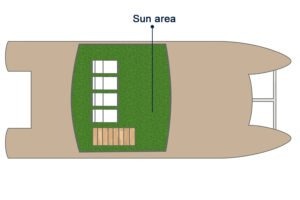
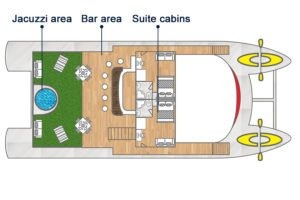
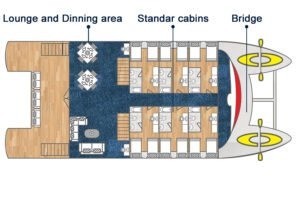
Technical Specifications
- Type: Motor Catamaran
- Category: First Class
- Build Year: 2006 | Guayaquil
- Length: 90.50 ft / 27.60 m
- Beam: 36.08ft / 11m
- Capacity: 16 passengers
- Main Engines: 2 x John Deere IMO 300 HP each
- Electric System: 2 x 65 kW generators (IMO) (110v and 220v. AC)
- Speed: 10 knots
- Water Capacity: 3000gal plus water maker with a capacity of 1000 gal/day
- Diesel Capacity: 2500 gallons
- Material Construction: Fibre Glass
- Interiors: Wooden flooring
- Exterior: Teakwood flooring
- Crew: 9 + 1 Galapagos naturalist bilingual guide
- Navigation Safety Equipment: Two 48 miles Radar; Echo sounder; GPS; VHF radio; Epirb; Magnetic compass; 2 Rigid life rafts for 15 passengers each; 30 SOLAS life jackets; fire smoke detectors; complete fire system; 2 Zodiac rafts for 10 persons each. Inmarsat Satellite Phone.
- Safety equipment complies with international Coast Guard regulations.
- Accommodation: 12 passengers in 6 twin bed standard cabins on main deck and 4 passengers in 2 suites on the upper deck.
- All cabins with private bathrooms, hot water and air-conditioning.
- Boat Name: Galapagos Anahi Catamaran
[tabby title=”ROUTE A”]
ROUTE A ( 8 DAYS)
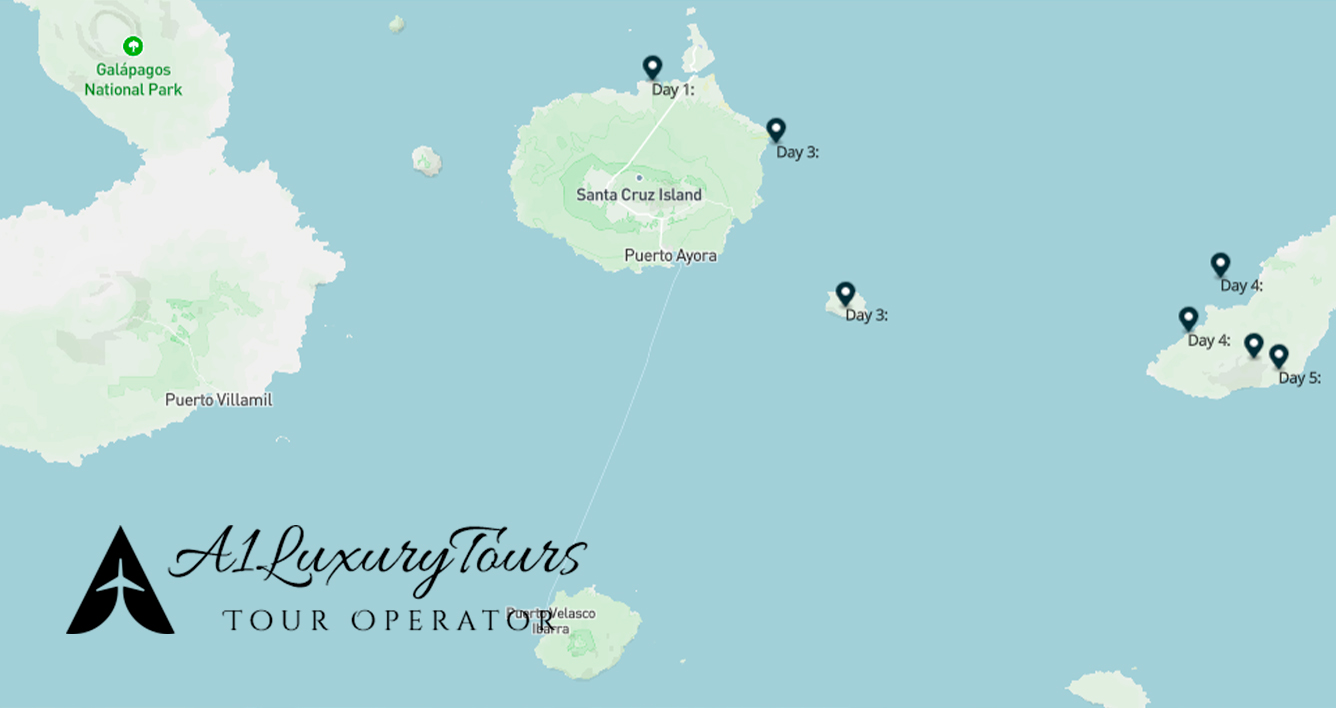
Galapagos catamaran west islands vacation itinerary 8 days M/C Anahi Cruise Tour
8 day cruise visiting the west isles of the Galapagos archipelago, this route includes visits to Fernandina, Isabela, Santiago, Bartolome amongst ohter Islands. An amazing trip that takes us to the remotest corner of this volcanic cluster of isles, tropical penguins, cormorants that cannot fly, giant tortoises, the famous pinnacle rock, snorkeling and sea kayaking alongside sea lions, turtles and manta rays. A stable ride on board the Anahi Catamaran ensures guests of all ages will enjoy the islands as well as their time on board.
Day 1: Santa Cruz Island: Highlands
Upon arrival at Baltra Island airport (from Quito or Galapagos, travelers pass through an airport inspection point to insure that no foreign plants or animals are introduced to the islands. After clearing the entrance to the national park, our guide will meet you at the lobby, collect your luggage, and escort you on the short (15 minutes) bus ride to the Itabaca Channel. After crossing the canal using a small ferry, we will board our bus for a 45 min / 1-hour drive towards the small city of Puerto Ayora.
From the pier of the town, motorized zodiacs (called ‘Pangas’) will transport you aboard the M/C Yacht Catamaran ANAHI. Once on board, our crew welcomes you with a refreshing drink and after being accommodated in your cabins you are invited for lunch and after a short rest.
At about 2 p.m. you will be transported to the highlands of Santa Cruz Island, up to a private farm where you will enjoy your first visit to the Galapagos Islands. Our guide will take you for a nice walk among the beautiful trees of the forest including ferns and sedges, miconias, etc. Here you will be amazed with the giant tortoises that roam freely in the farm, their natural habitat. The Tortoises are very shy, and will typically withdraw into their shells as soon as they see you coming close. It is very important not to bother, touch or feed these beautiful animals. The area also contains several species of birds including the famous Darwin finches, the rare “Pájaro Brujo” (Wizard Bird) with it’s beautiful red coloration, and many more. At this place we also find a simple but nice structure where you can rest and buy drinks, beers or a try delicious local fruit juices and snacks. Later on you’ll head to one of the many lava tunnels existing in the area. Here you enjoy of a short hike into the tunnel, where one can admire the amazing results of powerful volcanic eruptions occurred some 5 million years ago that shaped the islands we know now. We’ll head back to Puerto Ayora and to the yacht after this visit point, and at 7 p.m. you will have the official welcome drink followed by dinner. After dinner The guide will explain about the next day’s activities as well as some general recommendations for travelers in the Galapagos islands.
Day 2: Isabela Island: Puerto Villamil & Sierra Negra Volcano
Isabela Island is the largest and youngest islands in the Galapagos archipelago. From Puerto Ayora the navigation towards Isabela will start at about 1 a.m. arriving at about 6 a.m.to the port of Puerto Villamil. At 6:30 a.m. you will be awaked up by the guide and breakfast will be ready at 7:30 a.m.
At the morning, we start our first visit to the islets known as Las Tintoreras. Access to this location is easy where visitors can land during high or low tide to this beautiful visitor site located south of Puerto Villamil. It has a small bay of completely calm turquoise waters, where you can appreciate sea lions, sea turtles, marine iguanas, rays and many more species of Oceanside fauna and flora. The bay is connected to a shallow crevice of crystal clear water which closes when the tide is low, and is a favorite resting spot for sharks and fish life. Most of the trail in this visit point is “Ah Ah” Type Lava, except for a white sand beach and a black stone beach. The first beach we will encounter is popular with sea lions that are found sleeping peacefully, as well as marine iguanas that nest in the area. You can also see some Nolana galapageia plants, a rare endemic plant in the area not common in Ecuador, since this species is typical of continental coastal zones and belongs to a genus whose distribution is restricted to Chile and Peru.
The second beach is entirely surrounded by button mangrove (Conocarpus erecta) and white mangrove (Laguncularia racemosa). Throughout the trail you can see many marine iguanas in the rocks or under the mangroves.
Las Tintoreras is one of the few places where the iguanas breed successfully because of the absence of non-native animals that could kill the new born reptiles. Various parts of Las Tintoreras are ideal for nesting marine iguanas. During nesting season be very careful when exploring the area. Reef sharks (here known as Tintoreras) have nocturnal feeding habits and certain individuals remain inside the crevice and marine ponds during the day to rest. For this reason, you are not allowed to swim in this place. We’ll head back to the yacht for lunch and relaxing.
After the visit to Tintoreras, you disembark to Puerto Villamil to head up to the highlands of the Sierra Negra Volcano that is a large shield-type volcano located at the South eastern end of Isabela Island and it rises to an altitude of 1124m. It sits between with the volcanoes Cerro Azul to the west and Alcedo to the north. It is also one of the most active of the Galapagos volcanoes with the most recent historic eruption in October 2005.
Our guided tour of the volcano starts at Puerto Villamil with a car drive of about 30 minutes to where we start our 1 hour walk towards the rim of the giant caldera along its East side. The view is really amazing and impressive since the caldera, with dimensions of 7.2 x 9.3 kms, is considered the 2nd biggest crater in the world (after the Ngorongoro crater in Tanzania). From the several viewpoints located along the rim of the crater we can observe down inside of the crater the recent lava flow of the 2005 volcanic eruption. After another 2 hours hike from the rim of the Sierra Negra crater, the area known as Volcan Chico is located, an interesting sight where it is possible to observe some fumes, and explore this Martian-like landscape. From here we can also observe the faraway volcanoes of Isabela Island. This last visit is recommended for those tourists with good physical conditions and depends on the group.
After we take lunch, we will visit the area known as The Wetlands where you can see a variety of endemic wetland birds. Then of this visit we will have a free time in the small town of Puerto Villamil. We aboard the yacht for a well-deserved dinner and rest.
Day 3: Isabela Island: Punta Moreno & Elizabeth Bay
Punta Moreno is located on the north coast of Isabela Island between the volcanos Sierra Negra and Cerro Azul. The distance of the trail is about 2100 meters and runs along a lava flow of “Pahohoe” type lava (solidified lava in the form of corrugated cardboard or an accordion) into a complex of coastal lagoons. The vegetation found in the area is small and concentrated mainly in the mangrove area and around the lakes. It should be noted that the three kinds of cacti are found here amid black lava flows where there are several species of interesting birds. Here we also find a panoramic view of the three most active volcanoes of the Galapagos: are Sierra Negra, Cerro Azul both of Isabela Island and La Cumbre of Fernandina Island. Unfortunately, until the 1970’s a population of wild dogs that existed on this site fed on marine iguanas, sea lions and other marine species and drank the abundant brackish water present here, but are now eradicated. After this visit we return to the boat for lunch and a short rest before heading into our afternoon activity.
Special Indications:
Do not frighten the Flamingos. They are sensitive to noise and get scared easily. Stay within the group. The road to the large lagoon is long and dangerous, where you have to cross 700m of broken lava, making it somewhat difficult to walk. Wear comfortable and appropriate shoes for this type of hike. Due to high temperatures and strong sunshine, especially during the hot season (December to May), it is better to take the activity in the early hours of the day or late afternoon due to type of terrain.
Since there is no landing point at Elizabeth Bay, this excursion is carried out in a zodiac., this excursion starts into the cove that is surrounded by red mangroves where you can admire their red roots and green leafs. It is here that you are able to observe sea turtles, flightless cormorants, spotted eagle rays, golden rays, brown pelicans, and sea lions. Frequently visitors have been able to see Galapagos hawks soaring overhead while schools of Pompano and Dorado fish swim below. This site is really amazing due to the high quantity of land and marine wildlife as well as the unique and beautiful landscapes.
We’ll return to the yacht for dinner and rest.
Day 4: Isabela Island: Urbina Bay & Tagus Cove
This walking visitor site is located at the east base of the Alcedo volcano. The trail has an approximate distance of 3200m, and starts on the beach where a wet landing is made, and runs through sand, rock, lava, coral and vegetable formations in a coastal area. This area is considered amongst the best showcases of the geological formations of the islands as many aspects of the creation of the archipelago can be seen. The waters of the bay are a good place to see turtles and rays, as well as head into a short trail leading to a coral reef above the surface of the water, evidence of uplift from the sea which occurred in 1954.
From here it is easy to reach the Alcedo and Darwin volcanoes. Here you can see large, colored land iguanas, as well as giant Galapagos turtles, flightless cormorants, blue-footed boobies, Galapagos penguins, pelicans, and marine iguanas.
We will return to the yacht to enjoy a delicious lunch, followed by a short navigation to Tagus Cove. A tour along the cliffs in a zodiac will give the visitors a good chance to see the Galapagos penguin, the flightless cormorant and other sea birds. From the landing dock a 30-minute hike along the trail up to the top of the cliff takes you to a viewpoint of Darwin Lake, an uplifted ultra-saline lake. You can also see several volcanoes from this location. The route of the trail is about 1800 meters, and was considered a favorite spot for pirates and whalers, a tradition continued with the names of boats and ports. At the start of the walk, we find a small cave where we find inscriptions dating to the 1800s. The trail is mostly gravel, and leads into the interior of the island along Darwin Lake. During the walk, you can see various land birds and identify the characteristic vegetation of the arid zone.
Finally, we observe the lava fields of Darwin Volcano. Darwin Lake rests upon a “tuff” type cone, contains saltwater and its depth is approximately 9m. It has no fish and few forms of life due to its high salinity. Explosive volcanic eruptions must have occurred at the site, as the substrate has a large amount of volcanic rocks of different sizes, among the most common are little balls of nearly perfect spherical shape known as the “lapilli” or petrified rain.
Day 5: Fernandina Island: Espinoza Point & Islabela Island: Vicente Roca Point
Fernandina is the third largest island in the archipelago and has a single visitor site. Espinoza Point is located at the northeastern tip of the island, and is a narrow ledge of lava and sand that extends from the base of the volcano to the sea. The last recorded eruption of the island, occurred in May 2005 and lasted three days. The greatest recorded explosive eruption was in 1968, where two thirds of the caldera floor collapsed inwards to a depth of 300m.
In 1989 the last two land iguanas that inhabited this area died of starvation, and it is believed that these two animals came down from the flanks of the volcano, where they are numerous. Espinoza Point is a place famous for its large colonies of marine iguanas and as the habitat of unique species like the flightless cormorant, Galapagos penguin, Galapagos hawk, Galapagos snake, among others, as well as an ideal place to observe the lava cactus (Brachycerus nesioticus), which grows on young lava and can survive with little water. After this visit, is possible to snorkel in the area, where you can swim with marine iguanas, and large colonies of sea turtles, and if we are lucky, the beautiful seahorses.
Locals believe that Isabela Island has the shape of a sea horse, where is Vicente Roca Point is located at the mouth of the animal. Here the remains of an ancient volcano form two turquoise coves with a well-protected bay from the ocean swells.
From here, we take panga rides along the cliff to observe the remains of the volcano or explore a partially sunken cave at the water’s edge. Masked and blue-footed boobies sit perched along the point and the sheer cliffs, while flightless cormorants inhabit the shoreline. You can also see the fur sea lions, the incredible mammals very similar to the curious Galapagos sea lions.
The upwelling of cold-water currents in this part of the Galapagos, give rise to an abundance of marine life which, in combination with the protection of the coves, make Vicente Roca Point, one of the archipelago’s most coveted diving spots. The entire area of Punta Vicente Roca lies on the flank of the 790 m (2,592 ft) high Volcano Ecuador, the Island’s sixth largest volcano. At the end of our activity in the area, we will begin navigation, which will cross the equatorial line. At this point, we will have a special cocktail to celebrate the crossing to the northern hemisphere.
Day 6: Santiago Island: Egas Port & Rabida Island
The visitor site Egas Port is a black sand beach located on the west side of James Bay, northwest of Santiago Island. South of the beach is Sugarloaf Volcano, which has deposits of volcanic tuff, the same that has favored the formation of the black sand beaches across the archipelago. El Crater is just north of this site; and has a saltwater lagoon, which during the summer dry season becomes a salt mine which was attempted first between 1928 and 1930 to no major success, followed by a new attempt in 1964 which lasted for a longer period. These entrepreneurial attempts caused environmental damage due to the usage of native and endemic wood firewood and the introduction of invasive plants and animals.
This site is called Puerto Egas, after Mr. Hector Egas who attempted to exploit salt here and failed due to the price of salt in other areas of the country. The walk along the rugged shoreline, especially at low tide, will allow us to observe many marine species as Iguanas bask on the rocks and sea lions laying in the tide pools. At the end of the trail there is a series of grottoes or sea caves where fur seals and night herons are regularly found resting on the shady ledges.
You have the opportunity to snorkel from the beach of Puerto Egas, to enjoy the seascape relatively different from what we have seen in previous days.
In the afternoon we will visit Rabida Island, unique due to the red color of the rocks and sand. The volcanic material in this island is very porous and external factors such as rain, salt water, and sea breeze have acted as an oxidizing agent. Upon arrival we will enjoy a snorkeling activity, to learn about marine life in this area with interesting species.
Later we will visit the terrestrial visit site that is located on the east coast of Rabida Island, consisting of a red sand beach, a coastal lagoon behind the beach, and a loop trail. The approximate distance of the trail is 1.1 kilometers. A short walk along a trail will lead you to the lagoon to observe the beautiful land birds such as finches, doves, yellow warblers, and mocking birds. This lagoon is also a colony of Flamingos. The red sand beach, along with the animals, lagoons and vegetation make this a great visit spot!
Day 7: Chinese Hat Islet & Bartolome Island
After a nightly short navigation, you will dawn in the beautiful Chinese Hat Chanel. This small islet is located near the south-east coast of Santiago, and has been nicknamed according to its unusual shape akin to a Chinese Hat when seen from afar. Through observation and study of the island, it has been concluded that the lava flows near to its shoreline were formed under the sea and have been raised upward, which is why coral heads are found on the lava.This visit provides an excellent opportunity for the interpretation of geological features such as lava tubes and lava flows. The landscape is covered by sea lion colonies, marine iguanas, and Galapagos penguins.
The trail is 700 m (round trip) and the minimum time it takes this trek is half an hour at a moderate pace. You will swim on this wonderful bay with sharks, stingrays, fishes, and occasionally penguins, before to return to the yacht to enjoy a delicious barbecue on the Yacht ́s Upper Deck. Also, we could explore the area in Kayaks visiting the interesting geological formations from the surface.
Bartolome is one of the most famous points in the Galapagos, located across from Sullivan Bay near to Santiago Island. Arriving to this special site, we have the opportunity to swim around a pinnacle, and between rocks that salen to the surface forming amazing sea life labyrinths. first of the two main visitor sites provide the possibility to climb to the summit of the island, later, we visit the summit of the island, from where visitors can observe a variety of volcanic formations including lava bombs, spatter and cinder cones, lava flows, and lava tubes. The moon like landscape provides one of the most scenic panoramas in the archipelago.
At the second site, visitors have the chance to relax on a beautiful beach, which offers great snorkeling opportunities. Multi –colored fish and occasionally penguins and sea turtles have been seen at the base of the tall pinnacle rock, which dominates Bartolome’s landscape.
Day 8: North Seymour Island & Transfer out
North Seymour is located north of Baltra, our last visit in this itinerary aboard of Anahi Yacht, where the total distance of the trail is 3.5 km (2 miles). In 1932 and 1933, about 72 land iguanas from Baltra were introduced to North Seymour by Captain Alan Hancock and his crew with the intention that these animals could survive in better conditions than in Baltra, already populated by goats. The iguanas that the crew of Valero III (Hancock’s ship) taken from Baltra were undernourished and after the introduction into North Seymour in 1934 it was discovered that the iguanas had colonized the island without problems.
Later, during the Second World War when the United States occupied Baltra to install a military base, the land iguanas disappeared slowly as their habitat was altered for the construction of runways and barracks for soldiers and the invasive presence of goats, dogs and cats. By the end of 2008, 600 iguanas have been accounted for on North Seymour, of which 400 have been repatriated and 200 were born in the wild. Nowadays, with the eradication of introduced species in Baltra, we can find the population of the largest land iguanas in the archipelago, and with a very good area for its reproduction. The main vegetation bushy and low, hosting the largest nesting colony of Great Frigate birds in Galapagos.
[tabby title=”ROUTE B”]
ROUTE B ( 5 DAYS)
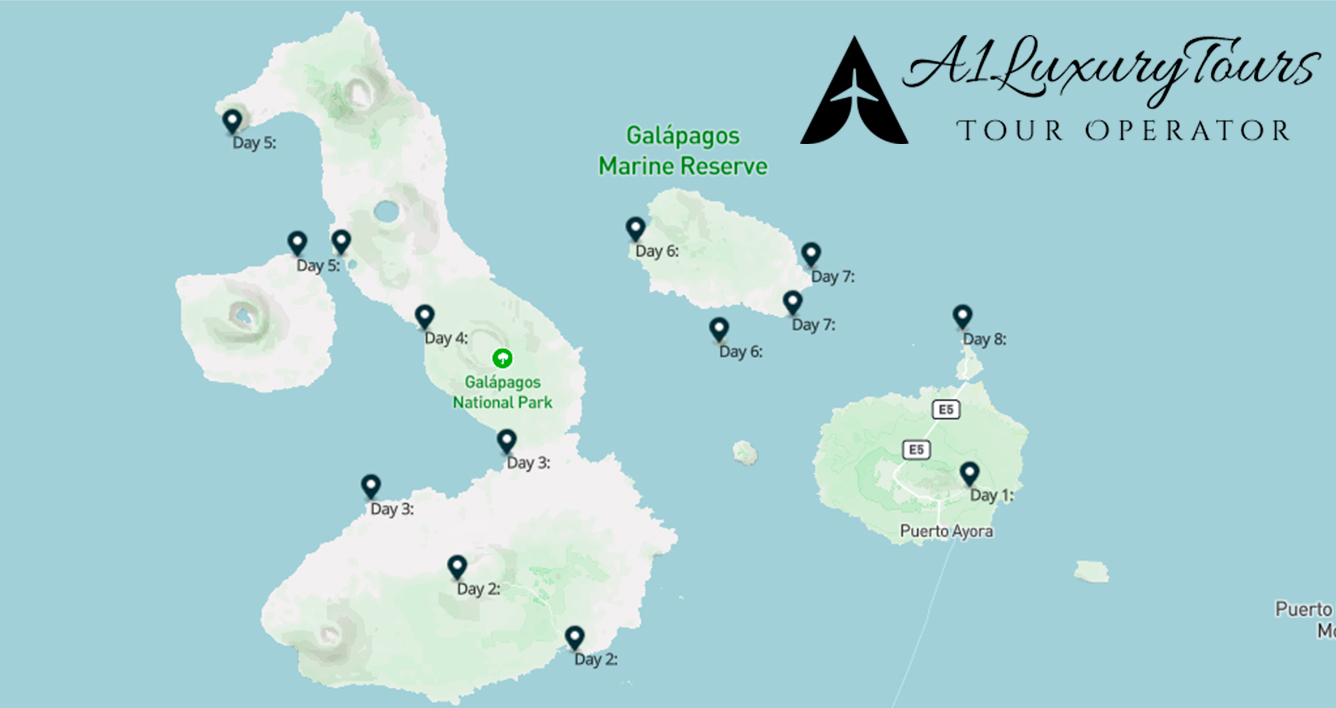
Day 1: Baltra Island & Santa Cruz Island: Bachas Beach
Your arrival will occur about midday (local time) where our guide will be waiting for you with a signboard with the name of our Yacht Anahi at the lobby. The baggage is taken care by one of our crew members who will transport them directly to the yacht. First we will be transported by public bus to the place known as “El Muelle” (pier) from where our zodiacs will be ready to take you to the Yacht Anahi. Our Captain and crew will welcome you with a drink and then you will be allocated in your cabins.
Following lunch, our guide will give us a short explanation about the afternoon activities. At about 2 p.m. we will disembark with our zodiacs to be taken to the place known as Playa Bachas. Their sand is made of decomposed coral, making it very white and soft, and a favourite nesting site for sea turtles. To a side of one of the beaches, we find a small lagoon where the occasional flamingo can be observed, as well as many other animal species such as the black-necked stilts and whimbrels.
The other beach is longer, and has two old barges that were abandoned during the Second World War when the US used Baltra Island as a military base. Here we will also encounter sea lions which rest on the beach, as well as marine iguanas and several marine birds. We will have some time to enjoy the calmness of the beach, as well as some time with playful sea lions that swim with visitors.
Day 2: Genovesa Island: Darwin Bay & Darwin Bay Beach
At 6 am. we will be arriving at Genovesa Island. This is the northeastern most Island in the Galapagos Archipelago also known as Tower Island with just 14 sq. km in size and a maximum elevation of 64 m (210 ft). The horse-shoe shaped island has a volcanic caldera whose wall has collapsed, forming the beautiful Great Darwin Bay, surrounded by high cliffs. Although no historical eruptions are known from Genovesa, there are very young lava flows on the flanks of the volcano.
Genovesa is also known as Bird Island, because of the large and varied bird colonies which nest here. There is an abundance of frigate birds and it is among the best place in the archipelago to see Red-footed Boobies, Nazca Boobies, Swallow-tailed Gulls, storm petrels, tropicbirds, Darwin’s finches, Galápagos Mockingbirds, the endemic Galapagos Dove and the short-eared owls.
The first visitor site is the Darwin Bay Beach, a very beautiful site due to the great abundance of sea birds that nest on the salt bush plants that dominate the area, which we will visit in the morning. In the afternoon we head to the second visitor point which known as the Prince Philip ́s Steps. We will accent 25 meters of stairs into one of the best bird nesting sites in the islands.
On Genovesa we will also have opportunity for panga ride, snorkeling, kayaking and walking.
Day 3: Plazas Island & Santa Fe Island
Our arrival to Plazas Islands will be at around 6 am after nighttime navigation. After breakfast we start our first visit in the morning. Plazas are two small islets that were uplifted a short distance from the East Coast of Santa Cruz. The unusual vegetation and location of the island create an interesting landscape in which the fauna and flora of Galápagos are enhanced. Moreover, despite its small size, some of the most interesting and outstanding species of the archipelago occur here.
It is possible to guarantee the observation of land iguanas that often are in the shade of a cactus. Nesting on the rugged southern cliffs, are usually swallow tailed gulls, along with various other sea birds. The protected rocky seashore is a prime habitat for a large colony of noisy sea lions. The main attractions of Plazas Island include the land iguanas, the sea lions and the swallow tailed gulls as well as yellow tailed mullets, Audubon’s shearwaters, red-billed tropicbirds, frigate birds, and brown pelicans gliding past the cliff. We return to the yacht for lunch and a well-deserved rest.
In the afternoon we start our second visit to Santa Fe (Barrington) Island. The small bay on Barrington’s northeast coast is extremely picturesque, where we can visit the two different trails, one leading to a scenic viewpoint on top of a cliff where it is possible to find land iguanas, endemic to the island. The other trail is near the beach and is a short circular trail where it is possible to find another colony of land iguanas, but early in the morning or in the afternoon when the sun is low. A particular attraction is the unusually tall forest of prickly cactus. Here we will also have the possibilities to do kayaking, snorkeling, panga ride and walks to observe and enjoy nature. We’ll then return to the yacht for dinner and relaxation time.
Day 4: San Cristobal Island: Punta Pitt, Kicker Rock & Lobos Island
In the morning we will arrive to San Cristobal (Chatham) Island the easternmost island in the Galápagos archipelago, and one of the geologically oldest. The name “San Cristobal” comes from the patron saint of seafarers, St. Christopher. English speakers increasingly use that name in preference to the traditional English name of Chatham Island, derived from William Pitt, 1st Earl of Chatham. The Island has an area of 558 km2 (215 miles2) and its highest point rises to 730 m (2400 ft). The capital of the archipelago, Puerto Baquerizo Moreno, is a small town lying at the south- western tip of the island. San Cristobal hosts a myriad of animal life including frigate birds, Galapagos sea lions, Galápagos giant tortoises, blue and red footed boobies, tropical birds, marine iguanas, dolphins, swallow-tailed seagulls and many more.
In the morning we visit Punta Pitt, considered as one of the most beautiful and impressive sites of Galapagos. The erosion of the high cliffs and the almost constant foggy morning gives to Punta Pitt an eerie atmosphere. Being the northeastern most point in Galapagos, it has become amongst the favorite nesting sites for sea birds. Here we can observe the three different species of boobies and great frigate birds nesting in the same area. We return to the yacht for lunch and in the afternoon we navigate towards the giant and impressive rocky formation locally known as “Leon Dormido” (sleeping sea lion). On the cliffs we can see lots of blue-footed boobies, masked boobies, pelicans and other several marine birds. During our snorkeling activity we can observe sharks, marine turtles, sea rays, and several species of colorful fishes next to the impressive rock formation.
Later on we go for a walk on Isla Lobos (Lobos Island), a small islet separated from the main Island by a narrow stretch of calm water. Upon its rocky shores blue-footed boobies nest and sea lions rest. The atmosphere is one of tranquility and primitive beauty: an example of the typical Galapagos environment.
Day 5: San Cristobal Island: Junco Lagoon, Cerro Colorado Galapaguera & Transfer out
In the morning our guide will take you up on the highlands of San Cristobal Island. Our tour starts from Puerto Baquerizo Moreno and our first visit point will be to the Laguna El Junco (El Junco Lagoon). Rainwater and condensation have collected for hundreds of years in the caldera of an extinct volcano, creating this haven for frigate birds. The lake in the main water supplier for the island population and thus of vital importance today. Hiking around the lake offers views of practically the entire island including San Joaquin Hill, the island’s highest point.
Our next stop will be at Cerro Colorado Turtle Breading Center. Here we can learn about the hard work developed by scientists in order to preserve the species of the Giant Galapagos Turtles. There is a nice walk on a trail which permits you to be in close contact with the turtles of the different sizes, from the tiny ones to the giant oldest ones.
[tabby title=”ROUTE C”]
ROUTE C ( 4 DAYS)

4 day wildlife tour in the Galapagos Islands on board the Anahi catamaran Cruise Tour
The world colony of waved albatross nest only on Espanola island in the Southern area of the Galapagos National Park, this tour takes you to Punta Suarez where you hike into their nesting grounds. Other important visits are the Galapaguera (Giant tortoise sanctuary and breeding center), Post Office Bay, Gardner beach with its white sand and turqoise waters. A short liveaboard cruise tour that allows to tap into the unique wildlife of the archipelago. The Anahi catamaran is a first class boat with 8 cabins, good service and all the necessary comforts to enjoy navigating the equatorial waters.
Day 1: San Cristobal Island: Interpretation Center, Cerro Tijeretas & Española Island: Carola Point
Flying from Quito or Guayaquil, you will arrive at around midday (local time) to San Cristobal where you will be greeted at the lobby by our guide, who will be waiting to take us to the Yacht Anahi. Our baggage will be handled by one of our crew members who will transport them directly to the yacht.
We’ll head to the dock to board the small Zodiacs to take us to the Yacht Anahi. Our Captain and crew will welcome you with a drink and then you will be allocated in your cabins. Following lunch our guide will give a short explanation about the afternoon activities. At about 2 p.m. you will disembark and start our walking tour to visit the Interpretation Center of San Cristobal, located in the outskirts of the small city of Pto. Baquerizo Moreno, the capital of the Galapagos Province. The interpretation center gives us a great introduction to the islands, from the natural and human history, to the actual efforts taken by the National Park and marine reserve to protect the fragile environment. We then walk up to the place known as Frigate Bird Hill.
This short hike starts from the interpretation Center and takes about 30 minutes to reach the top of the hill. Once there, visitors are treated to a spectacular view of the white beaches and the amazing Kicker Rock formation emerging from the Pacific Ocean, and the roofs of the houses of Puerto Baquerizo. The hill is often visited by Frigate birds who nest here in certain times of the year, thus giving it its name. Both the species of “Magnificent” frigate birds and “great” frigate birds can be seen here!
From the hill we descend towards the small cove known as Punta Carola, a place where we find a colony of cute sea lions. A great spectacle!
Day 2: Española Island: Punta Suarez & Gardner Bay
In the morning after a night boat ride, we will be arriving to Española Island, also known as Hood Island after Viscount Samuel Hood. It is located in the extreme southeast of the archipelago and is considered, along with Santa Fe, one of the oldest islands at approximately four million years of age. The island is slowly becoming a rocky, barren land with little or no vegetation, with sand and soft shingle beaches which attracts a healthy number of Galapagos Sea Lions.
We will visit the two spots that are especially popular with visitors: In the morning and after breakfast we will be visiting Suárez Point, a destination of great interest due of its abundance of bird-life. This island also has its own species of animals, such as the Española Mockingbird, which has a distinctive longer and more curved beak than variations in other islands; the Española lava lizard; the Marine Iguana of the subspecies venustissimus, which has red markings on its back; among others. We can also observe Swallow-tailed Gulls and other tropical birds that live in the rocky slopes. Amongst the most interesting attractions we find the Waved Albatross, where almost the entire world population arrives to breed here from March to January, and the mating dances of the funny Blue-footed Boobies. There are hundreds of masked Boobies, colonies of sea lions, huge colonies of marine iguanas, and different species of birds. We’ll return to the yacht for lunch and after a short rest we begin our afternoon visit to Bahía Gardner which has a lovely beach, excellent for swimming and snorkeling. Here we also find a big colony of playful sea lions and with luck we can observe Galapagos hawks and the local species of snakes, while almost certainly Darwin
finches, mocking birds and sea turtles.
Day 3: Floreana Island: Punta Cormorant, Devils Crown & Post Office Bay & Asilo de la Paz
Floreana Island was named after Juan José Flores, the first president of Ecuador during whose administration the government of Ecuador took possession of the archipelago. It was previously called Charles Island (after King Charles II of England), and Santa Maria after one of Columbus’ ships. The island has an area of 173 square km (67sq mi) formed by volcanic eruptions like most main islands of the archipelago, with the highest point being Cerro Pajas at 640m (2,100ft). In the morning we will go to Punta Cormorant, a site which probably offers the largest and best flamingo lagoon in the Galapagos. It is situated between two “tuff” type cones that give the area a special atmosphere. There are various species of shorebirds to be seen besides flamingos, the most frequent being stilts, white-checked pintail ducks and other migratory birds. This is a unique zone due to the high percentage of endemic (unique to the island) plant life. Here we see the “green beach” (due to high percentage of olivine crystals in the sand) and the “Flour sand beach” made up of coral which are two of the most interesting beaches of the islands. We can also snorkel from the beach around the area. We return to the yacht to start our snorkel activity at the place known as Corona del Diablo (Devil’s Crown). This is a submerged eroded volcanic crater where the interior of the formation is ideal for the sustainment of a wonderful coral reef habitat making it one of the most fascinating marine sites in the Galapagos. Here you can observe reefs, sea lions, reef fish, hammerhead sharks, and several other species of fish. We’ll return for lunch to the yacht, followed by a short navigation and rest period.
Our afternoon visit will be to the famous Post Office Bay, which historically served as a letter exchange station through the use of a wooden barrel that was placed in the 18th century by the crew of a whaling ship. Both Sailors and tourists have used this rudimentary system to exchange correspondence to every corner of the world! The idea is to carry letters or postcards to their destination by hand, thus creating a very special “Postal Service” apart from being the Post Office location this site was also the landing area for some of the first colonists. Later on we will visit the place known as “Asilo de La Paz” (Haven of Peace), known for its bizarre history as one of the first occupied spaces of the islands by a German family with the last name of Wittmer. After exploring the caves where this family used to live, we will return to our yacht to begin our navigation towards the port of Puerto Ayora, the biggest town in Galapagos.
Day 4: Santa Cruz Island: Charles Darwin Research Station & Transfer out
After breakfast, we will depart from our ship, and with the company of your guide we will visit a interesting attraction point before heading to the airport. We start with a walk in the Galapagos National Park “Fausto Llerena” turtle breeding and Interpretation Center where we can learn about the work done to maintain the species of this unique animal.
Then we will be transported to the Itabaca Channel which we cross with a local ferry to take a bus on the other side headed to the Airport of Baltra Island. Here our voyage ends, and we will say goodbye to our guide and to the Galapagos Islands, which wait for your next visit.
[tabbyending]

